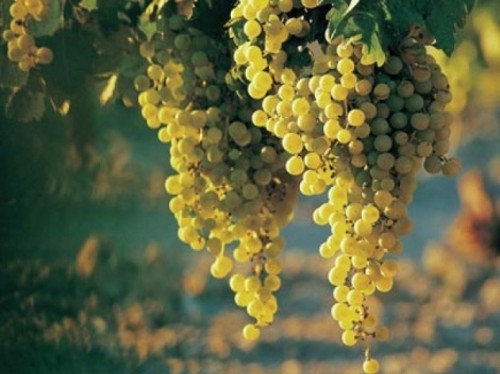During a recent, very enjoyable dinner at Fresco Italian Cafe—where chef Logen Crew is currently knocking it out of the park—I noted a bottle of Italian Verdicchio on the wine list. That’s something I don’t often see, and it caused me to wonder why we don’t find more Verdicchio on wine lists and in the wine stores. It seems to have become somewhat of an overlooked and misunderstood, if not downright maligned, grape varietal. And that seems odd to me, since Verdicchio is simultaneously inexpensive and quite versatile.
Verdicchio is a wine varietal—a type of grape. It’s indigenous to the Marches region of Italy and is named for the yellowish-green hue of the Verdicchio grapes. The indigenous Verdicchio grape has been grown in this region since ancient times, and Verdicchio remains the most important wine of the Marches region. A favorable climate and cheap land costs makes Marches an appealing place for growing Verdicchio and also Montepulciano grape varieties. DOC rules in Italy permit the use of up to 15 percent Malvasia or Trebbiano grapes in Verdicchio, and wines made with Verdicchio are similar to Pinot Grigio in style. They are relatively light in weight, but perhaps tending a little more toward Chardonnay in texture, color and mouthfeel.
Maybe one of the reasons that Verdicchio—which was popular in the 1970s and ’80s—lost its luster more recently is due to modern wine-making technology, which tended to strip the character from the wine and made it so super-clean that it was nearly tasteless. In fact, until recently, Verdicchio wines were virtually colorless. The light, straw hue of present-day Verdicchio can be attributed to later harvesting of the grapes and cold maceration before the wine is fermented. These practices have emboldened the color, as well as the taste and feel of today’s Verdicchio on the palate. Thankfully, the current trend backward to more traditional winemaking methods for Verdicchio includes allowing the grape more hang time on the vine in order to fully ripen and develop, resulting in more complex, concentrated flavors and aromas. Verdicchio has very distinctive aromas of pine and citrus.
The wine I spotted on the Fresco list was Fattoria San Lorenzo “Vigna di Gino” Verdicchio dei Castelli di Jesi Classico, Marches. That’s quite a mouthful and a lot to fit on one wine label. Fattoria San Lorenzo is a family-owned-and-operated winery that winemaker Natalino Crognaletti inherited from his father, Gino. Hence, Vigna di Gino. Castelli di Jesi Classico refers to a zone in the Marches region to the left bank of the Misa River, an area designated by the Italian DOC as “Classico”—theoretically meaning wines of higher quality. The soil and climate of this zone are perfect for producing dry, flinty white wines, thanks in part to clay- and limestone-rich soils and dry climate.
Fattoria San Lorenzo "Vigna di Gino" is a very good example of modern-day Verdicchio and sells here for about $12. It’s made from old clones of Verdicchio from an ancient vineyard, and Fattoria San Lorenzo vineyards are all organically and biodynamically farmed. All operations are done by hand in order to preserve the plants, soil and overall ecosystem and vineyard environment. In fact, Fattoria San Lorenzo was recently awarded the 2011 Chiocciola, the highest honor from Slow Food International’s Slow Wine guide, given for outstanding efforts in the area of sustainable winemaking and ethical practices in vineyard cultivation and vinification styles.
The wine itself is dry and crisp, with hints of lemon, melon, citrus and grass. It’s got nice acidity and a very clean finish. I’d drink it with most seafood, sushi and sashimi, lemony dishes like veal piccata, or fried calamari.
Speaking of Food & Drink, Slow
-
Jazz @ Vanina
Zesty Lunch, V-Day in Paris, Shallow Shaft + Epic
- Jan 21, 2014
-
Favorite Wines Of 2013
Can't-miss grapes from the past year
- Dec 24, 2013
-
Pinon Sold
Also: Sotelo to La Caille, Sage's on the Move
- Sep 17, 2013
- More »
More by Ted Scheffler
-
Flavor on the Western Front
Nomad Eatery ups the ante for off-airport eats.
- Dec 13, 2017
-
Under the Christmas Tree
Holiday gifts for cooks, foodies and winos
- Dec 6, 2017
-
Spreading the Love
Amour Café creates simple yet scrumptious fare.
- Nov 29, 2017
- More »





